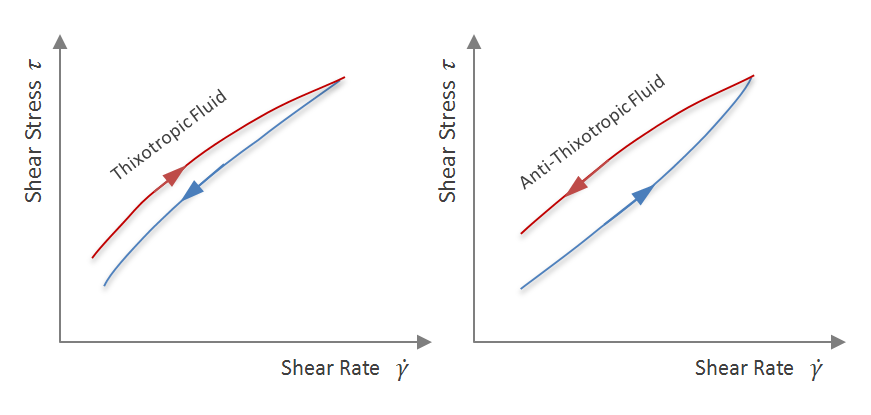Flow Properties of Polymers
Time-dependent Fluids
Many substances, particularly food, pharmaceutical and personal care products display flow behavior that depends on the shear history. Time-dependent changes in viscosity have also been reported for a number of polymer solutions and melts. Although most polymer melts and solution do not show any measurable time-dependency of viscosity. However, in a few cases, disentanglement of polymer molecules during shear can cause time-dependent effects, particularly when a dynamic physical network (gel) is dynamically formed and broken during stirring.
In most cases, time-dependent changes in viscosity are reversible, but in a few cases, shearing the polymeric material can cause irreversible changes.
It is believed that time-dependent flow behavior is due to the formation of a polymer network which is the result of reversible crosslinks which may be either broken (thixotropy) or formed (anti-thixotropy or negative thixotropy) during stirring. The later case is a rather rare phenomenon. A special case is rheopexy. It describes the gelation (solidification) of (polymeric) systems under gentle agitation (mechanical forces).

The time-dependent flow behavior can best be demonstrated using a cone-and-plate viscometer. The liquid is sheared at a constant velocity gradient (shear rate) for a certain time, for example for a minute at a low shear rate. The shear rate is then gradually increased and the torque measured at different shear rates. After reaching a certain torque, the shear rate is gradually decreased without stopping the measurement. In the case of a time-independent fluid, the two curves will coincide, whereas a hysteresis is evidence for a time-dependent fluid (see figures above).
Two examples of thixotropic liquids are very high molecular weight (MW ≥ 107) poly(methyl methacrylate) and polystyrene in a viscous solvent (η > 1 poise). An example of an anti-thixotropic liquid is polymethacrylic acid (PMA). It shows a 350 fold increase in viscosity when sheared at 10 s-1 for one minute.1 It was concluded that simultaneously occurring hydrophobic and hydrophilic interactions between PMA molecules, that are dynamically formed and broken during shearing, cause anti-thixotropic behavior.
1Seiji Ohoya, Shigeo Hashiya, Kyoji Tsubakiyama, and Togoro Matsuo, Polymer Journal, Vol. 32, No.2, pp 155 (2000)